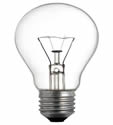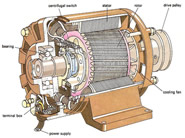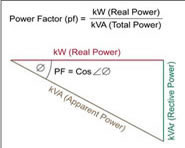| POWER FACTOR [’pau·’r ‚fak·t’r] -n A ratio of the apparant power delivered (kVA) and the actual amount of power used (kW). Power factor is an indication of efficiency. |

|
HOME | ABOUT US | FAQ |SERVICES| POWER FACTOR FACTS | UTILITIES WITH PF CHARGES | CONTACT US | PRODUCTS | |
|
|
|
|
|
|
| 1.What is Power Factor? |
Power Factor is an electrical term used to describe the ratio of kW to kVA or working power to apparent power. This is a measure of electrical efficiency. Working Power – The "true" or "real" power used in all electrical appliances to perform the work of heating, lighting, motion, etc. This is expressed as kW or kilowatts and are the consumed element of electrical power. Apparent Power, which is called kVA, (kilovolt-amperes) is the component of electrical power that comprises both the kW load as well as a non-consumed element known as inductive reactance commonly referred to as kilovolt ampere reactance or, kVAr. Every home and business has both resistive and inductive loads. Inductive loads such as motors and transformers require kVAr to operate whereas resistive loads such as incandescent lights and heating elements do not. The ratio between these two types of loads becomes important because as you add more inductive equipment the power factor may be adversely affected. For more information please click here. |
| 2. What causes poor power factor? |
There are two fundamental types of electrical devices that make everything work called resistive and inductive. |
| 3.How do I know what my Power Factor is? |
If your electrical utility company is charging you for your power factor it will sometimes be clear on the electrical bill, but it usually is not clear at all. Some electric utility invoices include both the kW and kVA demand but not the power factor. If this is the case simply divide the kW demand by the kVA demand as illustrated in the diagram to the right. Some electrical utility invoices have a charge called "Reactive" or "kVAr Charge" but do not show the actual power factor. If this is the case it may require additional work and data to calculate to determine the power factor and you must contact the appropriate department at the utility for more information. Click here for more information We can assist you in determining how good or bad your power factor is with an analysis of your electrical billing invoice. In addition to this we can accurately calculate the additional cost of your low power factor if it’s not clear on your invoice, as well as provide you with a budgetary cost estimate to correct it with our Quick PF Report. |
| 4.How do I know if my Power Factor is costing me additionally on my power bill? |
If your electrical utility company is charging you for your power factor it will be stated on the electrical bill in some way. It may be called a "kVAr" or "Excess kVAr Charge", "Reactive Demand Charge", "kVA Demand Charge" (not be confused with kW Demand) to name a few. Often it’s not very clear but we can help with a review of your electrical bill. There are over 3,000 electric utilities that distribute and deliver electrical power to businesses and homes in the USA regardless if they generate it themselves or just transport it from some other "supply" company. They all have one thing in common and that is they charge for that service but most have different ways of calculating the cost. This can be very confusing and frustrating to figure out. Many of their customers do not ask questions and accept the bill as something they can do nothing about. If this is you, please get in touch with us. We can assist you in determining how good or bad your power factor is with an analysis of your electrical billing invoice. In addition to this we can accurately calculate the additional cost of your low power factor if it’s not clear on your invoice and provide you with a budgetary cost estimate to correct it. Here is a little more information on this subject. |
| 5. If I purchase my power from a third party, does my Power Factor still affect me? |
Yes, the electrical power is delivered to you by the local electrical utility regardless of whether you purchase the kWh’s from another company. This is sometimes refered to as a "Demand Charge". This is similar to when UPS and FedEx delivers a product to you. The local utility charges to carry the electrical power (product) from where it is generated to you. The power factor cost is part of your Delivery Charge or Demand Charge. |
| 6.What can be done to improve my Power Factor? |
Typically a power factor improvement can be done cost effectively with the installation of GE Ultravar power factor correction capacitor unit equipment. The power factor correction equipment needs to be selected and ordered specifically for your unique requirements. If this is done incorrectly, it can cause major issues and possible equipment failure. Click here for more information |
7.Where do I begin to see if I can benefit from a Power Factor Improvement? |
If you allow us to perform a Quick PF Report and a review of one or more electrical bill, we can tell you if a Power Factor Correction improvement will be cost effective for you. If so we can provide you with a complete PF system design and/or a turnkey project. |
| Copyright © 2013 E Power Factor | | Plymouth MA 02360 | 508.747.4744 | Sitemap |
 strip of metal that resists the flow of electricity creating light, heat or both. These are very simple electrical devices or loads. A resistive load has a perfect power factor in that no kVAr is required.
strip of metal that resists the flow of electricity creating light, heat or both. These are very simple electrical devices or loads. A resistive load has a perfect power factor in that no kVAr is required. An inductive load, like motors, transformers or lighting ballasts, requires a component of power that a resistive load doesn’t which is called inductive power (inductive reactance) to generate and sustain a magnetic field in order to operate which is expressed in kVAr (kilovolt ampere-reactance). The reactive power is not actually consumed but is required for an inductive load to operate.
An inductive load, like motors, transformers or lighting ballasts, requires a component of power that a resistive load doesn’t which is called inductive power (inductive reactance) to generate and sustain a magnetic field in order to operate which is expressed in kVAr (kilovolt ampere-reactance). The reactive power is not actually consumed but is required for an inductive load to operate.
